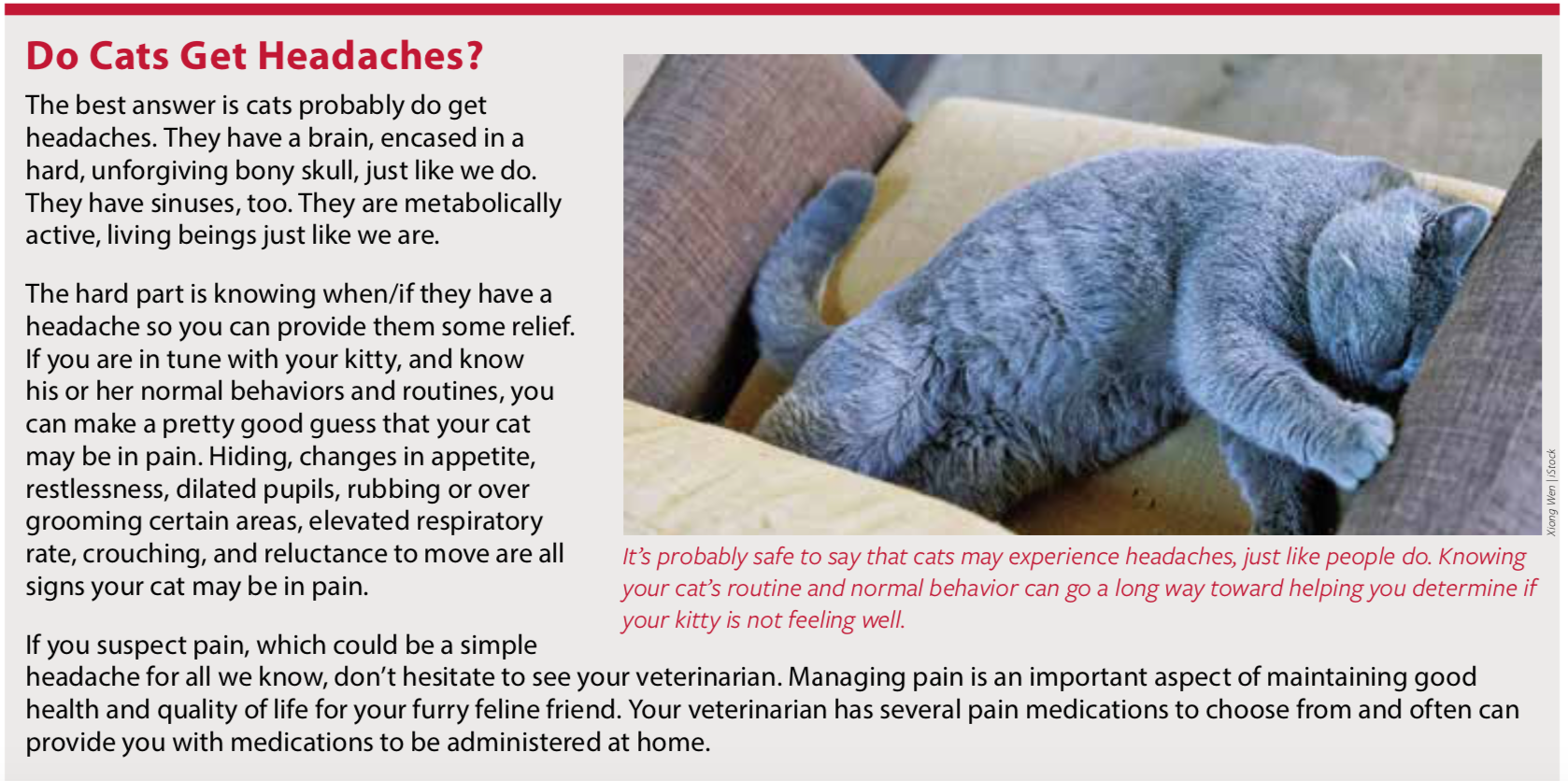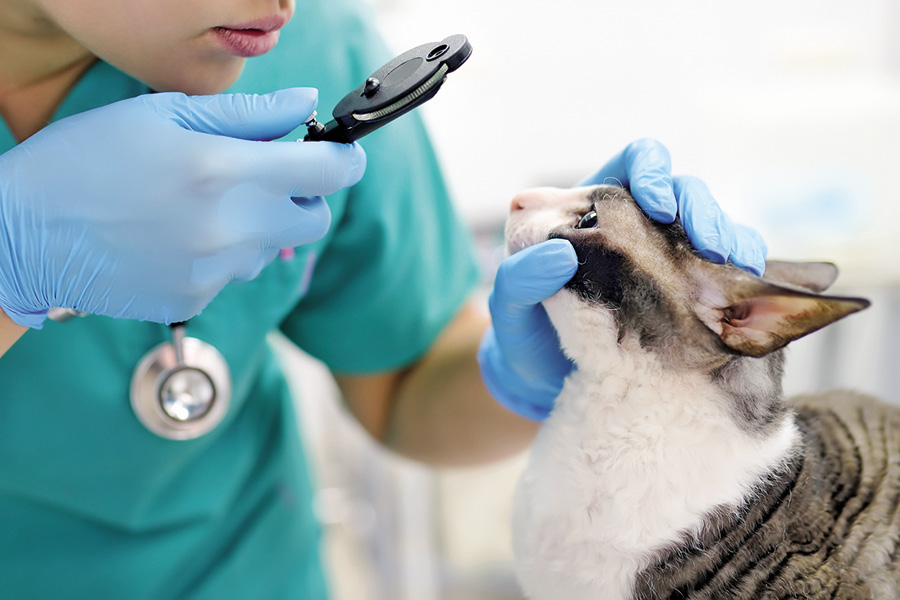Because cats are such small creatures, when they suffer a trauma resulting in brain injury, there are usually additional injuries—to the skull, eyes, jaw, neck, chest—that may complicate treatment, prognosis, and recovery. It’s critical to get immediate treatment for the best chance of recovery.
The most common causes of head trauma in cats are:
- Vehicular trauma, aka hit by a car
- Falls from high places
- Attack by a larger animal (bites, violent shaking)
- Kicks from a person or animal
- Being hit with an object
- Gunshots and pellet gun wounds
- Crushing injuries (heavy object falling on the cat, head shut in a door, recliner coming down on them)
Head Injuries Are Serious
An injury to your cat’s head is much more serious than trauma to other tissues. While impact to the skin may result in bruising, bleeding, and swelling, this tissue usually has room to swell. Because the brain is encased in the small, hard case of the skull, though, damaged brain tissue has no room to swell. The result is increased intracranial pressure that compresses surrounding brain tissue and worsens the damage to the brain.
The increased pressure also compresses blood vessels, diminishing blood flow and oxygen delivery to the brain. The result is rapid brain cell death. In addition, most trauma victims arrive at the veterinary clinic in shock, which is a sudden, severe drop in blood pressure and blood flow, adding to the lack of oxygen delivery to the brain.
Signs of Head Trauma
It’s often obvious that your cat suffered a head injury, even if you didn’t see the accident. You may see wounds, swelling, bleeding, trouble breathing, lameness, weakness, lethargy, balance/gait problems, and/or depression. This is a veterinary emergency. If you witnessed the trauma, have your cat examined as soon as possible even if he looks OK to you. There may be subtle neurologic derangements you cannot see.
Signs of a brain injury include:
- Change in demeanor or personality: quiet, withdrawn, hiding, delayed or no response to stimulation, or extreme agitation or unusual aggression
- Changes in the appearance of the pupils: both pupils extremely small, both pupils extremely dilated, or pupils are markedly different sizes
- Blindness
- Jerking eye movements: either side to side or up and down
- Weakness, staggering, loss of balance
- Head tilt or tremor
- Recumbency (laying down either on stomach or side unable to rise)
- Stiff limbs
- Seizures
- Coma: alive but unresponsive
En Route to the Clinic
When traveling to the veterinary hospital, stabilize and support the cat’s head and neck in 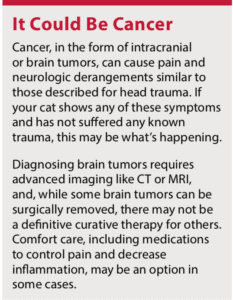 case there are cervical (neck) fractures. Have your cat positioned with the head elevated at about a 30-degree angle from horizontal. This helps blood drain from the head and may help lessen the intracranial pressure increase common with head trauma.
case there are cervical (neck) fractures. Have your cat positioned with the head elevated at about a 30-degree angle from horizontal. This helps blood drain from the head and may help lessen the intracranial pressure increase common with head trauma.
When you get to the veterinary hospital, if your cat’s injuries look severe, expect him or her to be swept away to the treatment area for immediate triage, evaluation, and emergency treatment.
Time is of the essence. Even once your cat is stabilized, be prepared for a recommendation of referral to a 24/7 critical care center for ongoing intensive care for the first couple of days. Many critical care centers now have CT scanning and other advanced imaging capabilities, which are useful for evaluating the extent of the head injuries, including intracranial hemorrhage and skull fractures.
Veterinary Care
As with any traumatic injury, the first things addressed are called the ABCs of critical care: airway, breathing, and cardiovascular status. Remember, the cat is likely in shock. Until adequate blood flow and tissue perfusion is reestablished, there will be ongoing injury to the brain and other organs. Supplemental oxygen and intravenous fluids are typically administered.
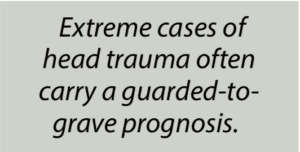 The next step is usually a full neurologic evaluation to assess the degree of brain injury and a thorough, full body exam to assess for any additional injuries.
The next step is usually a full neurologic evaluation to assess the degree of brain injury and a thorough, full body exam to assess for any additional injuries.
Extreme cases of head trauma often carry a guarded-to-grave prognosis.These are the cats who present comatose, with dilated unresponsive pupils and no signs of improvement after initial shock treatment. Your veterinarian will likely discuss with you the reality of your cat’s prognosis so that you can make informed decisions for your pet.
Cats presenting with milder signs of brain injury may carry a more favorable prognosis, but this can change depending on how the case progresses in the first 24 to 48 hours.
The important things being continually monitored and managed are neurologic status, body temperature, blood oxygen and carbon dioxide levels, blood pressure, blood sugar, and electrolyte levels.
Medications to lessen brain swelling and lower intracranial pressure may be administered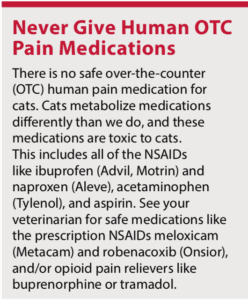 by the veterinarian.
by the veterinarian.
Your doctor will usually reassess your kitty every 30 to 60 minutes over the first several hours. If the cat is stable at that point, reassessment by your veterinarianr may be extended to every four hours, with a dedicated licensed veterinary technician providing continuous assessment and care for the injured kitty.
If your cat suffered other body or head injuries, anything life-threatening will be addressed right away, along with the treatment for brain injury and shock. Anything non-life-threatening requiring surgical intervention will most likely be postponed until the brain injury has improved. This may include jaw fractures, eye injuries that require removal of the eye, non-compressive skull fractures, and limb fractures.
It may be painful for you to see your kitty suffering with these other injuries, but your veterinarian will be making pain control a priority for you cat. Methods of pain control have advanced appreciably over the past decade.
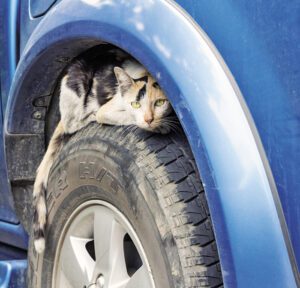
Cats are pretty clueless when it comes to vehicular safety, although hopefully this one would run at the sound of the engine.
Prognosis
Cats who are successfully stabilized from the head trauma/brain injury and have had other injuries successfully treated are usually going to be OK. Some patients will have residual neurologic deficits, like a head tilt or changes in the way they walk. These things may slowly improve over time, but it’s more important that your kitty is comfortable, willing to eat, able to move freely, engaging, and happy. Fortunately, cats don’t tend to suffer from chronic seizures in the aftermath of head trauma like dogs and humans do.
The biggest thing to remember with head trauma is that although things may look awful at the start, especially after if the accident included being hit by a car, many cats make a full recovery. This is due to advances in veterinary diagnostic and therapeutic capabilities, access to safe and highly effective pain medications for cats, and the cat’s own amazing ability to heal.
